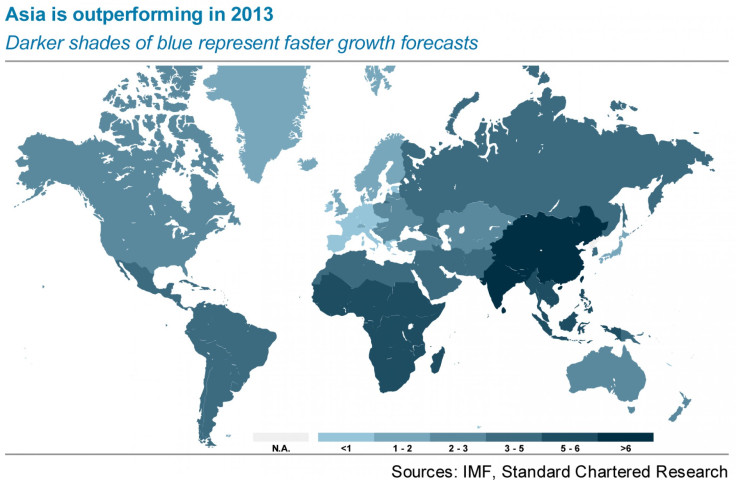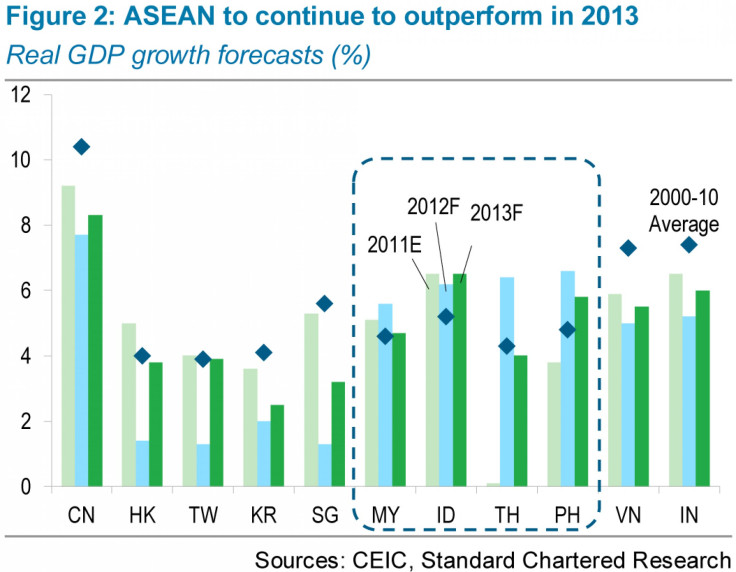Asian Economies To Outperform In 2013; ASEAN Countries’ GDP Growth In The Spotlight

Growth momentum in Asia was solid at the end of 2012 and economists at Standard Chartered Bank are confident that 2013 will be stronger than last year, supported by increased confidence, domestic spending and intra-regional trade.
Although growth could be even stronger, Asia is clearly outperforming the world as well as other emerging regions.
Fiscal tightening and political uncertainty will make it difficult for the U.S. to achieve more than 2 percent gross domestic product growth this year. The latest Reuters poll showed that economists are looking an anemic growth rate of 1.8 percent for 2013 as a whole, down from the 1.9 percent seen in the February poll. In 2012, the U.S. economy grew by 2.2 percent.
“We expect uncertainty to increase as we approach the next debt-ceiling deadline in May,” Marios Maratheftis, Dubai-based head of research for Standard Chartered Bank, said in a note to clients.
While an agreement is likely, a long-term solution that will reduce uncertainty looks unlikely. “Given the current political environment, one should not be overly optimistic,” Maratheftis added.
Europe, which is expected to stay mired in recession, is not doing any better than the U.S. Although the European Central Bank pulled the euro back from the brink last year, the root cause of the problems in the euro area remains unresolved.
The peripherals remain uncompetitive compared to core countries like Germany. Without the option of devaluing their currencies to restore competitiveness, southern European countries are under pressure to cut salaries and proceed with internal devaluations.
With youth unemployment at 60 percent in Greece and 50 percent in Spain, rising social pressures in the single currency bloc should not be underestimated.
Meanwhile, on the other side of the world, countries in Southeast Asia are forecast to see substantial growth this year.

Indonesia. Despite faster inflation, Standard Chartered’s Eric Alexander Sugandi expects real GDP growth to accelerate from 6.2 percent in 2012 to 6.5 percent this year, and 6.8 percent in 2014, driven by household consumption (around 55 percent of GDP) and investment. The pick-up in inflation is likely to have a minimal impact on household purchasing power, as household income is also rising, aided by the minimum wage increase and an annual salary increase for civil servants. The economy will also receive a boost from election-related spending by political parties in the fourth quarter of this year and early next year.
Malaysia. Being one of ASEAN’s strongest domestically driven economies, Malaysia is likely to enjoy sustained investment growth in 2013, while also benefiting from an improvement in external conditions, according to Jeff Ng, a Singapore-based economist at Standard Chartered. Ng forecasts that GDP growth will slow to 4.7 percent this year from 5.6 percent in 2012, entirely due to base effects. GDP growth has been relatively stable since the second half of 2010, after recovering from an externally driven slowdown in 2009.
Myanmar. Economist Usara Wilaipich at Standard Chartered expects foreign direct investment (FDI) inflows to be a key driver of growth in 2013 and beyond, with further diversification of investment from the energy sector to the manufacturing, tourism, agricultural, and banking sectors. Meanwhile, stronger-than-expected rice exports are a potential source of upside surprise for Myanmar’s economic growth in 2013. The Myanmar Rice Industry Association expects the country’s rice exports to hit 1.5 million metric tons in 2013, up about 88 percent from 2012. Agriculture accounts for about one-third of Myanmar’s GDP, employs the majority of the workforce and makes up nearly 30 percent of the country’s total exports.
Philippines. Standard Chartered’s Ng said 2013 is likely to be another year of domestically driven growth for the Philippines. Ng is optimistic that the Philippines will outperform the region and enjoy another year of strong growth momentum in 2013. He’s looking for Philippines’ GDP to grow 5.8 percent this year, higher than the 10-year average of 5.2 percent for 2003-2012.
Singapore. Singapore’s growth outlook for 2013 remains subdued, according to Edward Lee, head of regional research for Southeast Asia at Standard Chartered. Lee expects still-lackluster GDP growth of 3.2 percent this year, following a weak 1.3 percent in 2012.
Thailand. Economists at Standard Chartered have penciled in a 2013 GDP growth rate of 4 percent. They believe that consumption-led growth may not be sustainable given higher household debt, while Thai baht (THB) appreciation is not supportive of the export outlook. Manufacturing production is forecast to grow a modest 3 percent to 4 percent this year given the recovery in the electronics sector. Although auto production surged 73.1 percent in 2012, the overall manufacturing production index rose a moderate 2.5 percent. Production of textiles and electronics products continued to shrink by 17.7 percent and 14 percent, respectively, despite the delivery of the backlog of export orders after the floods. This suggests that the production recovery in 2012 was not broad-based but driven largely by the auto sector, likely as a result of the one-off tax rebate.
Vietnam. Vietnam has approved a master plan to boost the economy, focusing on restructuring the banking sector and state-owned enterprises during the 2013-2020 period. Betty Rui Wang, an economist in Hong Kong at Standard Chartered, said she expects a mild recovery in Vietnam in 2013 after below-trend growth in 2012. GDP growth will likely pick up to 5.5 percent this year, from 5 percent in 2012.
© Copyright IBTimes 2024. All rights reserved.






















